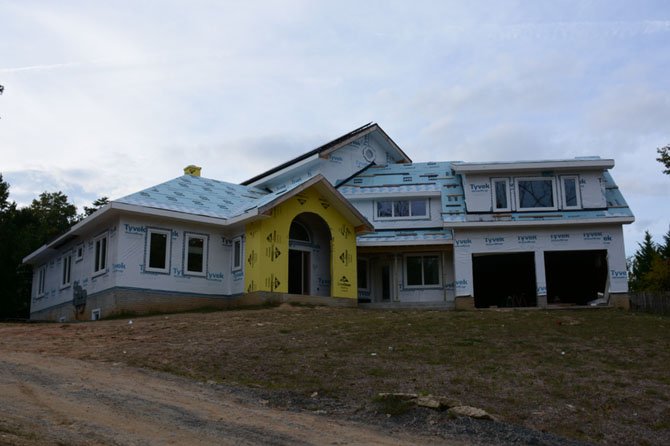This Springfield house should generate more electricity than it needs. Photo by Tim Peterson.
Once completed, this house will generate more electricity than it requires to operate. More and more houses are employing grids of solar panels to supplement the electricity they draw from power companies. Forty panels on the roof of this Springfield residence will help generate 12 megawatts of electricity a year, 10 more than what the owner expects to need.
The house will run two Dominion electricity meters (input and output) and be part of the company’s Solar Purchase Program. The homeowner will technically own the solar power system but sell the net positive energy, as well as the solar Renewable Energy Certificates earned, back to Dominion.
To achieve such a difference, the solar panels have to work in concert with a host of energy-saving measures.
“There probably isn’t another house like this on this planet,” said John F Heltzel, whose Manassas firm John F Heltzel AIA has been handling the design and implementation. “It’s unbelievably complex.”
Every inch of the roughly 4,000-square-foot home is custom, and literally lined with energy-saving features. Some of the most notable on a job site walk-through are a central courtyard (the numerous additional windows help spread more natural light throughout the house), single-sheet insulated wall panels (replacing the typical stud-foam-stud model), a geothermal heat pump (complete with three underground thermal wells) and a foundation of 12.5-inch thick thermomass insulated concrete.
“It’s not uncommon that I get someone who wants to do this type of foundation design, or thermal system, or roof framing,” said Heltzel. “Maybe one or two gets sprinkled in. The owner wanted all of them.”
Putting all these systems together in one place not only makes the design complex, but mucks up the county approval process as well. The project has been ongoing since the owner’s family moved to Northern Virginia in 2010.
“When you go against the grain, you have to prove everything,” Heltzel said, “throw away the code book and explain how this whole thing’s going to work.”
Heltzel estimates the process of getting county approval took easily over 100 hours more than what would normally occur. The owner puts the total cost of the job around 20 percent more than a more “normal” house of its size.
“I’m just so relieved for the family it’s finally coming together and they can see it’s actually happening,” Heltzel said.
